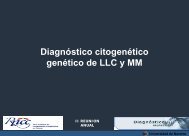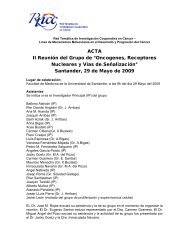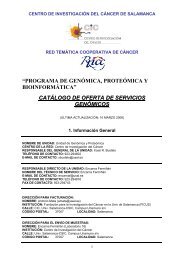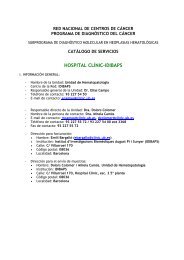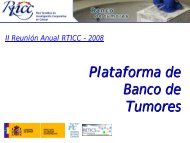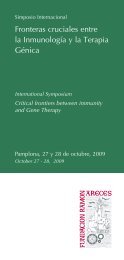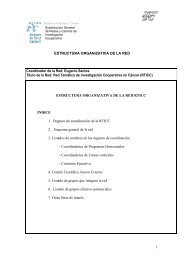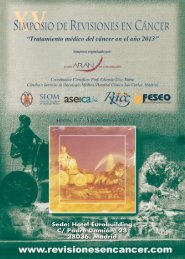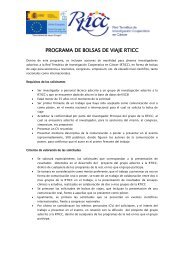Untitled - Red Temática de investigación cooperativa en cáncer
Untitled - Red Temática de investigación cooperativa en cáncer
Untitled - Red Temática de investigación cooperativa en cáncer
You also want an ePaper? Increase the reach of your titles
YUMPU automatically turns print PDFs into web optimized ePapers that Google loves.
P-28<br />
EFFECTS OF GAMMA-SECRETASE INHIBITORS IN RHABDOMYOSARCOMA<br />
MOUSE MODELS<br />
MOLIST C 1 , ALMAZÁN-MOGA A 1 , ROMA J 1 , GARCIA M 2 , DOLL A 2 , REVENTÓS J 2 , SÁNCHEZ DE<br />
TOLEDO J 1 , GALLEGO S 1<br />
1<br />
PEDIATRIC ONCOLOGY AND HEMATOLOGY UNIT, HOSPITAL UNIVERSITARI VALL D’HEBRON, UNIVER<br />
SITAT AUTÒNOMA DE BARCELONA, BARCELONA (RD06/0020/1021)<br />
2<br />
RESEARCH UNIT IN BIOMEDICINE AND TRANSLATIONAL AND PAEDIATRIC ONCOLOGY, VALL<br />
D’HEBRON INSTITUT DE RECERCA (VHIR), UNIVERSITAT AUTÒNOMA DE BARCELONA, BARCELONA<br />
(RD06/0020/0058)<br />
Background: Rhabdomyosarcoma (RMS) is a malignant tumour <strong>de</strong>rived from myoblastic<br />
precursors of skeletal muscle. It is a rare disease with an inci<strong>de</strong>nce of 5.3 cases/million/<br />
year affecting mainly childr<strong>en</strong> un<strong>de</strong>r 15 years old. Curr<strong>en</strong>t treatm<strong>en</strong>ts inclu<strong>de</strong> chemotherapy,<br />
surgeryand radiotherapy, with 5-year overall survival of 60-65%. Our previous in vitro<br />
studies suggest that inhibition of the NOTCH pathway bygamma-secretase inhibitors produces<br />
a significant <strong>de</strong>crease in invasiv<strong>en</strong>ess of RMS cell lines in culture. Moreover, NOTCH<br />
pathway activation seems to play a crucial role in the activation of the N-Cadherin.<br />
Objectives: To establish the animal mo<strong>de</strong>ls and to ascertain theeffects of NOTCH pathway<br />
inhibition using murine x<strong>en</strong>ograft mo<strong>de</strong>ls of RMS in an attempt to find new molecular targets<br />
for treatingpati<strong>en</strong>ts with RMS.<br />
Methods: Intramuscular and intrav<strong>en</strong>ous injection of RH-30 RMS cells into SCID mice and<br />
treatm<strong>en</strong>t with NOTCHpathway inhibitors.<br />
Results: Primary RMS tumours showed a reduction in size wh<strong>en</strong> treated with the gammasecretase<br />
inhibitor DAPT.Curr<strong>en</strong>tly, the mo<strong>de</strong>l of metastasis (by intrav<strong>en</strong>ous injection of<br />
RH-30 RMS cells) is un<strong>de</strong>r <strong>de</strong>velopm<strong>en</strong>t.<br />
Discussion: The characterization of the NOTCH pathway in RMS murine x<strong>en</strong>ografts in<br />
combination with the use of NOTCH pathway inhibitors may lead to noveltherapeutic strategies<br />
for childr<strong>en</strong> with high risk or recurr<strong>en</strong>t rhabdomyosarcoma. We hypothesize that<br />
the use of specific NOTCH pathwayinhibitors in vivo, in a x<strong>en</strong>ograft mouse mo<strong>de</strong>l of RMS,<br />
could lead to new co-adjuvant treatm<strong>en</strong>ts for pati<strong>en</strong>ts with metastatic disease orhigh risk<br />
of <strong>de</strong>veloping metastasis.<br />
P-29<br />
MOLECULAR EVENTS IN ENDOMETRIAL CARCINOSARCOMAS AND THE<br />
ROLE OF HMGA2 IN ENDOMETRIAL CARCINOGENESIS<br />
ROMERO-PÉREZ L 1 , CASTILLA MA 1 , DÍAZ-MARTÍN J 1 , MORENO-BUENO G 2 , PALACIOS CALVO J 3<br />
1<br />
INSTITUTO DE BIOMEDICINA DE SEVILLA (IBIS), SEVILLA (RD06/0020/0013)<br />
2<br />
INSTITUTO DE INVESTIGACIONES BIOMÉDICAS “ALBERTO SOLS”-UAM ”/ FUND.MD ANDERSON<br />
CANCER CENTRE, MADRID<br />
3<br />
HHUU VIRGEN DEL ROCÍO-IBIS/ HHUU RAMÓN Y CAJAL, MADRID (RD06/0020/0013)<br />
The molecular ev<strong>en</strong>ts implicated in the <strong>de</strong>velopm<strong>en</strong>t of <strong>en</strong>dometrial carcinosarcoma (ECS)<br />
remain poorly un<strong>de</strong>rstood. Using cDNA microarrays, we analyzed a group of 15 ECSs and<br />
compared their g<strong>en</strong>e expression profiles with those obtained from a group of 23<strong>en</strong>dometrioid<br />
<strong>en</strong>dometrial carcinomas (EECs).<br />
We <strong>de</strong>monstrated changes in the expression of g<strong>en</strong>es modulating processes such as the<br />
epithelial-mes<strong>en</strong>chymal transition (EMT), muscle differ<strong>en</strong>tiation, the expression of cancer/<br />
testis antig<strong>en</strong>s (CTAs) and immune response in ECSs.<br />
The HMGA2 g<strong>en</strong>e (High Mobility Group AT-hook 2) is an embryonic nuclear factor that<br />
mediates EMT in various tumor mo<strong>de</strong>ls and it was among the g<strong>en</strong>es overexpressed in<br />
ECSs. HMGA2 overexpression was confirmed in 54% of ECSs by qRT-PCR and immunohistochemistry.<br />
Moreover, we found a significant inverse correlation betwe<strong>en</strong> the expression<br />
of HMGA2 and let-7b, a member ofthe let-7 family of miRNAs that represses HMGA2 expression.<br />
These changes were also associated with overexpression of Lin28B, a suppressor of microRNA<br />
biog<strong>en</strong>esis that is implicated in cancer progression and metastasis.<br />
Finally, HMGA2 overexpression, which was <strong>de</strong>tected in less than 3% of EECs, was observed<br />
in many non-<strong>en</strong>dometrioid carcinomas (NEECs) (46% of 28 samples).<br />
This pattern of expression, restricted to NEECs and ECSs, reflects a role for HMGA2 in <strong>en</strong>dometrial<br />
carcinog<strong>en</strong>esis that is associated with aggressive ph<strong>en</strong>otypes, and points to its pot<strong>en</strong>tial<br />
use as a marker to distinguish betwe<strong>en</strong> <strong>en</strong>dometrioid and non-<strong>en</strong>dometrioid tumors.<br />
* This study was performed in collaboration with Xavier Matias-Guiu (HHUU Arnau <strong>de</strong> Vilanova,<br />
IRBLLEIDA, Lleida. RD06/0020/0134) and Jaime Prat (Hospital Sant Pau, Barcelona.<br />
RD06/0020/0015)<br />
72 73



